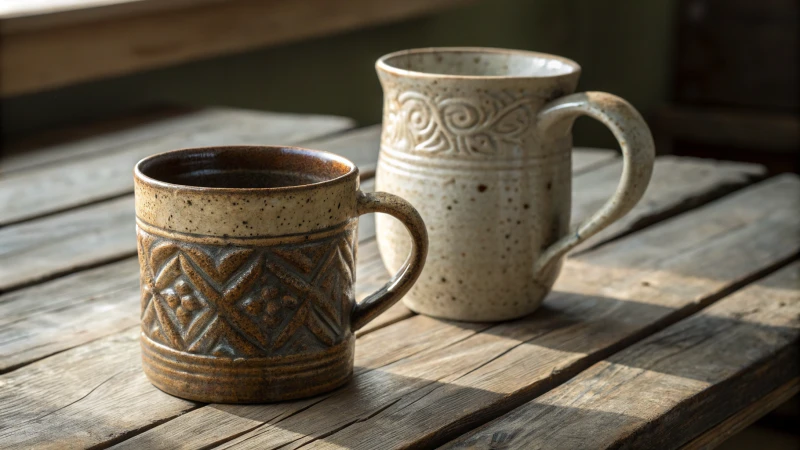
Choosing the right mug can enhance your coffee experience. But what’s the difference between stoneware and ceramic mugs?
Stoneware mugs are typically more durable and resistant to wear compared to ceramic mugs, which offer a broader range of designs and styles. The choice ultimately depends on your specific needs, such as durability, heat retention, and aesthetic preferences.
To help you navigate this decision, we’ll delve into various aspects such as the production processes, heat retention capabilities, and safety considerations of both materials. Understanding these factors will empower you to select the perfect mug for your coffee rituals.
Stoneware mugs are more durable than ceramic mugs.True
Stoneware is known for its durability and resistance to wear, making it a better choice for long-term use compared to ceramic.
Ceramic mugs offer fewer design options than stoneware mugs.False
Ceramic mugs typically come in a wider variety of designs and styles compared to the more uniform appearance of stoneware.
What Are the Key Differences in Durability Between Stoneware and Ceramic Mugs?
When it comes to choosing between stoneware and ceramic mugs, durability is a key consideration. Let’s explore the critical differences that can influence your decision.
The key differences in durability between stoneware and ceramic mugs stem from their water absorption rates, production processes, and resistance to chipping or cracking. Stoneware is generally more robust than ceramic, making it ideal for daily use.
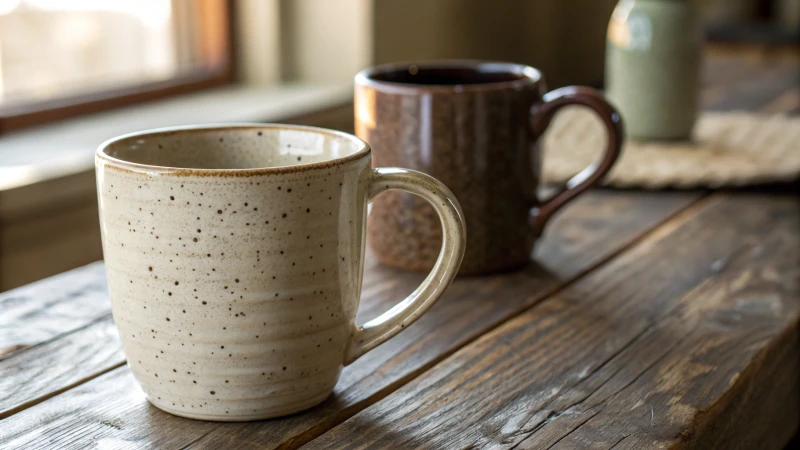
Understanding Durability in Material Science
Durability in ceramics is influenced by various factors including composition, firing temperature, and structure. Stoneware and ceramic mugs are both made from clay but differ significantly in their properties. Stoneware is fired at a higher temperature, resulting in a denser and less porous material compared to traditional ceramics. This higher density makes stoneware more robust and resistant to chipping and cracking under normal usage conditions.
For instance, when considering thermal shock resistance, stoneware can withstand sudden temperature changes better than ceramic mugs. This property is crucial for users who might pour hot liquids into a cold mug or vice versa. Therefore, if you frequently enjoy hot beverages, opting for stoneware could be beneficial. To delve deeper into the characteristics of ceramics, you can check out ceramics properties.
Water Absorption Rates
The water absorption rate of a material gives insight into its durability. As mentioned earlier, stoneware typically has a water absorption rate of 0.5% to 3%, while ceramic mugs usually have a rate of less than 0.5%. This means that stoneware can absorb more moisture, which could potentially affect its longevity if not maintained properly.
Here’s a comparative table illustrating the differences in water absorption:
| Material | Water Absorption Rate | Durability Level |
|---|---|---|
| Stoneware | 0.5% – 3% | High |
| Ceramic | <0.5% | Moderate |
This table indicates that while stoneware is generally more robust, it may require careful handling to prevent moisture-related damage over time. For those interested in the maintenance of ceramic materials, you can explore care for ceramic.
Production Processes and Cost Implications
The production methods used for stoneware and ceramics also contribute to their differences in durability. Stoneware is typically made using a less complex process, which results in lower production costs. In contrast, ceramics often undergo more intricate manufacturing techniques leading to higher prices. However, this complexity can enhance the aesthetic appeal and finish of ceramic mugs.
Cost can also be an indicator of durability; higher-priced ceramic mugs might offer superior durability features like glaze quality that resists scratching. The following table highlights these aspects:
| Type | Production Process | Average Cost | Durability |
|---|---|---|---|
| Stoneware | Simple | Lower | High |
| Ceramic | Complex | Higher | Moderate |
Choosing between stoneware and ceramic should be aligned with your intended use and budget. For those interested in exploring the manufacturing nuances further, check ceramic manufacturing.
Conclusion Insights
While the comparison doesn’t lead to a definitive conclusion, understanding the nuances in durability between stoneware and ceramic mugs can help users make informed decisions based on their needs. Remember that personal preferences also play a critical role in selecting the right mug for your daily use or gifting needs. For more tips on selecting durable mugs, visit selecting durable mugs.
Stoneware mugs are more resistant to thermal shock than ceramics.True
Due to higher firing temperatures, stoneware can handle sudden temperature changes better, making it less likely to crack under hot liquids.
Ceramic mugs generally have a lower water absorption rate than stoneware.True
Ceramic mugs absorb less moisture, typically under 0.5%, enhancing their durability compared to stoneware's 0.5% to 3% absorption rate.
How Does Heat Retention Vary Between Stoneware and Ceramic Mugs?
Discover how heat retention differs between stoneware and ceramic mugs, impacting your coffee or tea enjoyment.
Heat retention varies significantly between stoneware and ceramic mugs, with stoneware generally retaining heat better due to its density and thickness, making it ideal for hot beverages.
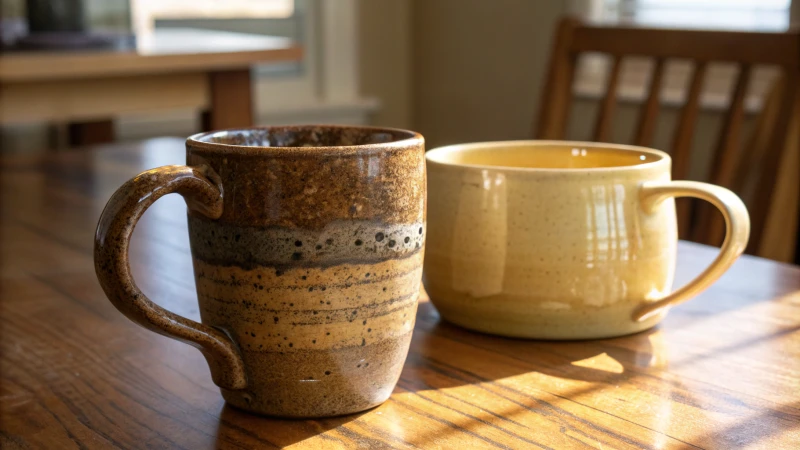
Understanding Heat Retention
Heat retention refers to the ability of a material to hold and maintain heat. In the context of mugs, this property is crucial for enjoying hot beverages like coffee or tea.
Stoneware mugs, made from dense clay and fired at high temperatures, typically exhibit better heat retention than traditional ceramic mugs. This is due to their thickness and density, which can help in maintaining the temperature of the drink for a longer time.
Conversely, ceramic mugs, while often lighter and more aesthetically pleasing, may not retain heat as effectively. The water absorption rate in ceramics is usually less than 0.5%, which allows them to cool down faster compared to stoneware.
For those interested in exploring the nuances of heat retention, consider checking out the properties of stoneware versus ceramic materials.
Practical Examples of Heat Retention
To illustrate these differences, consider the following table comparing stoneware and ceramic mugs:
| Property | Stoneware Mugs | Ceramic Mugs |
|---|---|---|
| Heat Retention | High | Moderate |
| Water Absorption Rate | 0.5% – 3.0% | <0.5% |
| Thickness | Thicker | Thinner |
| Ideal For | Coffee, tea, soups | Hot drinks, casual use |
As you can see, stoneware mugs are ideal for those who want their beverages to stay warm longer. This makes them suitable for serving items like hot soups or coffee during long gatherings.
Factors Influencing Heat Retention
Several factors influence heat retention in both materials:
- Material Composition: Stoneware’s dense composition contributes significantly to its heat retention capabilities.
- Thickness: Thicker walls generally provide better insulation. Stoneware tends to be thicker than most ceramic options.
- Design: Some ceramic mugs are designed with double walls that can enhance heat retention, but this is less common.
- Temperature of Beverage: Starting temperature plays a critical role; hotter beverages will naturally stay warmer longer regardless of material.
For further reading on how design impacts heat retention, consider mug design principles.
Conclusion: Making an Informed Choice
When choosing between stoneware and ceramic mugs based on heat retention, understanding these differences is key. Think about your specific needs—whether you prioritize longevity in warmth or aesthetic appeal.
To dive deeper into product comparisons, you might want to check out stoneware vs ceramic comparisons to inform your purchasing decision.
Stoneware mugs retain heat better than ceramic mugs.True
Due to their density and thickness, stoneware mugs maintain beverage temperature longer than lighter ceramic mugs.
Ceramic mugs have a higher water absorption rate than stoneware.False
Ceramic mugs typically absorb less water, contributing to faster cooling compared to the denser stoneware.
Are There Any Health or Safety Considerations When Using Stoneware or Ceramic Mugs?
Curious about the health implications of your favorite stoneware or ceramic mugs? This section covers essential safety considerations you need to know before enjoying your beverages.
When using stoneware or ceramic mugs, be aware of potential health risks like toxic glazes containing lead or cadmium. Opt for certified non-toxic products to ensure safety during daily use.
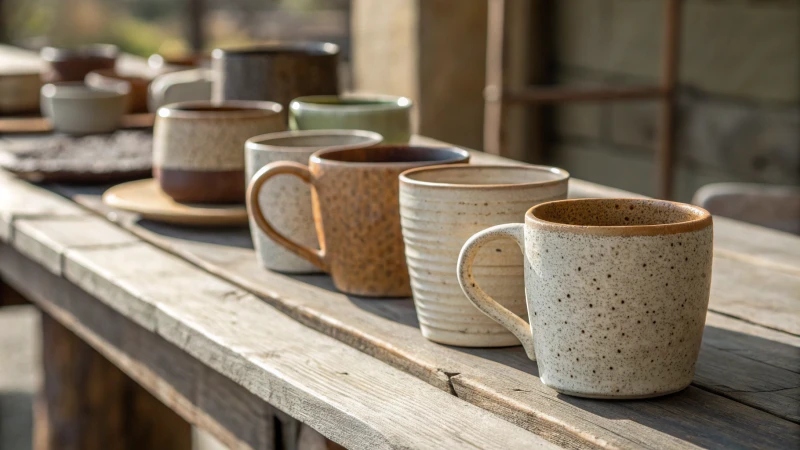
Understanding Material Safety
When considering the safety of stoneware and ceramic mugs, it’s important to examine the materials used in their production.
Some ceramics can contain harmful substances like lead and cadmium, particularly in their glazes.
Thus, checking for certification such as FDA approval can ensure that the mugs are safe for food contact.
Toxic Glazes and Their Risks
Toxic glazes may leach chemicals into food or beverages.
Lead glaze, often used in vintage ceramics, can pose significant health risks.
| Material | Health Risks | Safety Measures |
|---|---|---|
| Lead Glaze | Neurological issues, especially in children | Ensure products are labeled as lead-free |
| Cadmium | Kidney damage, cancer risk | Look for certification from reputable sources |
Choosing Safe Products
When purchasing stoneware or ceramic mugs, consumers should opt for products from reputable manufacturers who follow safety regulations.
Products labeled as non-toxic and lead-free are generally safer choices. For more information on safe ceramic options, refer to resources on ceramic safety.
Proper Care and Maintenance
To enhance the longevity and safety of stoneware and ceramic mugs, proper care is essential.
Avoid using metallic scrubbers or harsh chemicals when cleaning, as these can damage the glaze, potentially allowing contaminants to leach into food or drinks.
Furthermore, consider using gentle cleaning solutions and soft cloths for maintenance.
Health Implications of Using Recycled Ceramics
Recycled ceramics can sometimes contain harmful substances due to previous use.
Consumers should research the sourcing of recycled materials to understand any potential risks.
For more insight, explore articles about recycled ceramic safety.
The Importance of Manufacturer Transparency
In today’s market, it’s crucial for manufacturers to be transparent about their production processes.
Look for companies that provide detailed information about their materials and safety certifications.
This transparency can significantly reduce the risk of purchasing potentially harmful products.
Lead glazes in ceramics can pose health risks.True
Lead glazes may leach harmful substances into food and beverages, especially affecting children.
All ceramic mugs are safe for food contact.False
Not all ceramic mugs are safe; some may contain toxic materials like lead or cadmium.
Which Type of Mug Is More Aesthetic: Stoneware or Ceramic?
When deciding on the perfect mug to enhance your kitchen’s aesthetics, two popular options stand out: stoneware and ceramic. Which one truly shines in terms of style?
Choosing between stoneware and ceramic mugs depends on personal aesthetic preferences. Stoneware offers a rustic charm with earthy tones, while ceramics provide vibrant colors and intricate designs, appealing to different tastes.
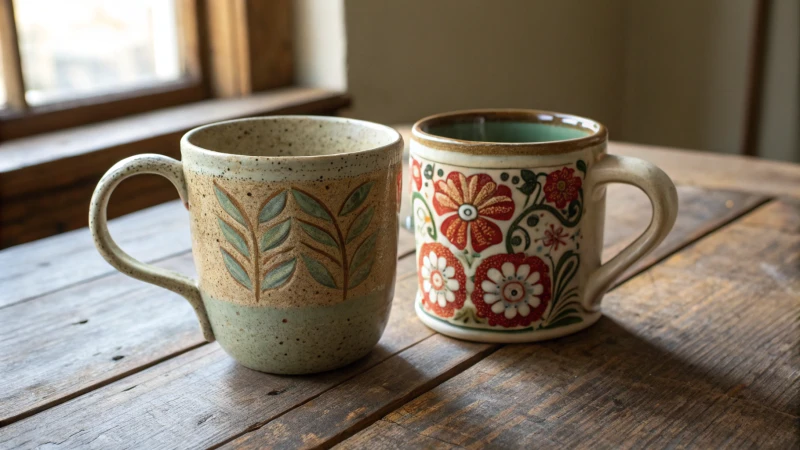
The Aesthetic Appeal of Stoneware Mugs
Stoneware mugs are known for their rustic charm and earthy tones. They often feature unique glazes and textures that can enhance any kitchen or dining decor.
Their sturdy build gives them a handcrafted feel, appealing to those who prefer an organic look. Many stoneware pieces come in muted colors, making them versatile for various design styles, from farmhouse to contemporary.
For example, a set of handcrafted stoneware mugs can add a touch of warmth to your table setting, making them ideal for both casual and formal gatherings.
The Aesthetic Qualities of Ceramic Mugs
Ceramic mugs, on the other hand, offer a wide range of designs, colors, and finishes. The smooth surface of ceramic allows for vibrant prints and intricate patterns that can cater to diverse tastes.
Unlike stoneware, ceramic can be shiny and glossy, making it visually striking. This quality often attracts those looking for something modern or playful.
Consider how a bright, colorful ceramic mug can brighten your morning routine or serve as a delightful gift for a friend. You might explore ceramic mug collections that showcase seasonal designs or thematic patterns that resonate with personal style.
Durability vs. Aesthetics
When it comes to durability, stoneware generally outperforms ceramic due to its dense composition and lower porosity. This robustness means that stoneware mugs can withstand daily use and resist chipping better than many ceramic options.
However, this does not mean that ceramic lacks durability; high-quality ceramics can also be quite strong. The choice often depends on individual preferences regarding aesthetic versus functional use.
| Feature | Stoneware | Ceramic |
|---|---|---|
| Durability | High (resistant to chips) | Moderate to High (depends on quality) |
| Appearance | Rustic, earthy tones | Vibrant colors and patterns |
| Weight | Heavier | Lighter |
| Cost | Generally less expensive | Can be more costly due to complexity |
Choosing Based on Personal Style
Ultimately, the choice between stoneware and ceramic should align with your personal aesthetic preferences. If you enjoy a rustic vibe and appreciate the uniqueness of handcrafted items, stoneware may be the way to go.
Conversely, if you prefer bold colors and intricate designs, ceramic mugs could be more appealing. Each type offers a distinct aesthetic that can complement various kitchen styles.
For those interested in exploring more about design aesthetics, it’s beneficial to consider how each mug’s appearance fits into your overall decor scheme. Consider visiting local stores or online retailers to see which material resonates with you most!
Stoneware mugs have a rustic aesthetic appeal.True
Stoneware mugs are known for their earthy tones and unique textures, enhancing kitchen decor with their rustic charm.
Ceramic mugs are always more durable than stoneware mugs.False
While ceramic can be durable, stoneware generally outperforms it due to its dense composition and resistance to chipping.
Conclusion
Discover the key differences between stoneware and ceramic mugs in terms of durability, heat retention, safety, and aesthetics to make an informed choice for your coffee experience.